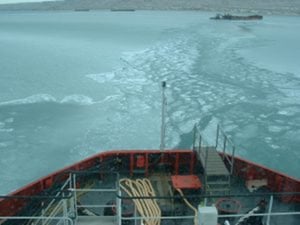In November 2014, IMO’s MSC (Maritime Safety Committee) accepted the international code for ships operating in polar waters. The Polar Code went into effect on 1 January 2017.
The Code provides an international framework that is to protect the polar areas (the North Pole and South Pole regions) against maritime risks. In a prior blog we spoke about what the Polar Code exactly entails. In the coming blogs we will delve deeper into the three conventions that make up the Polar Code: SOLAS (International Convention for the Safety of Life at Sea), MARPOL (International Convention for the Prevention of Pollution from Ships) and STCW (International Convention on Standards of Training, Certification and Watchkeeping for Seafarers) which was adopted in May 2016. We will begin this series with the MARPOL Convention.
What is MARPOL?
The International Convention for the Prevention of the Pollution of the Sea by Oil (OILPOL) dating from 1954 was at the basis of the Convention. The shipwreck of the Torrey Canyon in 1967, the largest oil disaster at the time, was a key motivator for establishing the Convention. The Convention was signed on 17 February 1973, but only went into effect following the addition of the Protocol in 1978. After a sufficient number of countries had ratified the Convention, it went into force on 2 October 1983. As at 31 December 2005, 136 countries had signed the Convention. These countries represent 98% of the transport by ship, measured by weight.
It is the most important international convention for the prevention of pollution of the maritime environment by ships due to operational or incidental causes. The Convention currently comprises six technical annexes. Special areas with strict controls on operational discharges are included in most annexes.
Annexes from MARPOL that are applicable to the polar code
- Annex I – Regulations for the Prevention of Pollution by Oil
Covers the prevention of pollution due to accidental or operational causes. The rule that oil tankers (new and existing) must have double hulls forms part of this Annex. - Annex II – Regulations for the Control of Pollution by Noxious Liquid Substances in BulkThe criteria for discharge and measures for the control of pollution by noxious liquid substances in bulk transport. Approximately 250 liquid substances have been evaluated and are recorded on a list in the Convention. The discharge of residues is allowed only to reception facilities with certain concentrations and conditions (this can vary in accordance with the category of substances). In any event, no discharge of residues containing noxious substances is permitted within 12 miles (19.4 km) of the nearest land.
- Annex IV – Prevention of Pollution by Sewage from ShipsContains requirements to control pollution of the sea by sewage from ships. Discharging sewage into the sea is prohibited, except when the ship has an approved treatment system, as well as a number of exceptions.
- Annex V – Prevention of Pollution by Garbage from ShipsDeals with different types of waste and specifies the distance from land and the way in which it can be discharged. Discharging plastics is prohibited for all forms of plastic.
Existing and new ships that are certified under MARPOL must meet the environmental requirements as of 1 January 2017.
Green sealing solutions
Various sealing solutions are available to make your ship environmentally friendly and meet the provisions of the Polar Code. A number of these sealing solutions is described below:
- Supreme Ventus ©
The Supreme Ventus air-type seal is the seal that guarantees you zero oil-emissions, an absolute minimum of wear and enables you to check the condition of the seal. It is suitable for vessels with a varying draught and vessels that want to prevent oil-emission. - Supreme® WLC
The Water Lubricated Floating seal has been especially developed to prevent water leakage from your open water lubricated stern tube systems into your machine room. It is an environmentally friendly solution in line with VGP regulations which allows for in situ maintenance and Condition Monitoring. - Water Lubricated Forward seal
The Water Lubricated FWD seal is especially developed to prevent water leakage from your open water lubricated stern tube system into your machine room. It’s an environmentally friendly sealing solution in line with VGP regulations which is repositionable to realign with shaft and has an optimised and extended seal lifetime


